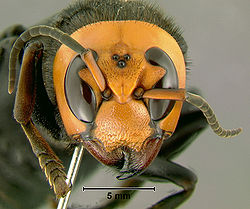

The Asian giant hornet, Vespa mandarinia, also known as the Japanese hornet and known colloquially as the yak-killer hornet, is the world's largest hornet, native to temperate and tropical Eastern Asia. Its body length is approximately 50.8 mm (2.0 in), with a wingspan of about 76 mm (3 in).[1] Queens may reach a length of 55 mm (2.2 in).[2] Due to its size, it is known in Japan as the giant sparrow bee (大雀蜂 oo-suzumebachi?).
Between 20 and 40 people die each year in Japan after being stung by giant hornets.
A few interesting notes on Vespa mandarinia's venom and stinger:
- The venom contains at least eight distinct chemicals, some of which damage tissue, some of which cause pain, and at least one which has an odor that attracts more hornets to the victim.
- The venom contains 5% acetylcholine, a greater concentration than is present in bee or other wasp venoms. Acetylcholine stimulates the pain nerve fibers, intensifying the pain of the sting.
- Vespa mandarinia uses its large crushing mandibles, rather than its sting, to kill prey.
- The venom of the Asian giant hornet is more toxic than that of most other bees or wasps, giving this species one of the greatest lethal capacities per colony.
- The enzyme in the venom is so strong that it can dissolve human tissue. On some occasions, the sting may be compared to the effects of a spider bite.
- Like all hornets, V. mandarinia has a barbless stinger, allowing it to sting repeatedly.
















